#engineers expeditionary forces
Explore tagged Tumblr posts
Text
WIP WEDNESDAY
Hey look buddy, He's an engineer. That means he solves Problems. Not problems like "what is beauty," Because that would fall under the pervue of your conundrums of philosophy...



He solves Practical Problems, Like "How do I stop some big mean Motherhubbord from giving me a structurally superfluous new behind?"

The answer, Use A Gun, and if that don't work, Use Moar Gun. And if that don't work then its time to Return to Tradition and break out Ol' Reliable, his ancestral Greataxe.

I think he looks right at home, ranked up with the rest of the Warband.
#warhammer#homebrew#wip wednesday#warhammer fantasy#miniature painting#art wip#fantasy#warhammer the old world#the old world#scale model#dwarfen mountain holds#dwarfen engineer#engineers expeditionary forces
2 notes
·
View notes
Text
Between the Black and Grey 64
First / Previous / Next
Fen tried to lean forward to get a better view of what Han'iel was doing, but she was still strapped tightly to the table. She tried to speak, but her mouth was still covered.
"Nothing you need to worry yourself about, Empress - or rather, former Empress" Han'iel said. Fen could hear him tapping on a pad just out of sight. In fact, here-" He loosened the cover over her mouth. "You can't hurt me now, so you may speak if you wish."
"Former Empress?"
"Yes, the beacons I linked out announced your abdication as well as an announcement of the K'laxi's independence, and a call to arms to resist the human empire's tyranny."
No. He's lying.
"Han'iel... what is your plan?"
He stuck his head around the table so that Fen could see him. His ears waggled a grin. "You'll learn in time, just like everyone else." He tapped on his pad some more as he walked back into Fen's view. "In fact, here, you can see the first part of our plan." He turned his pad so that Fen could see it. On the screen was a confused mess of light and streaks of energy, but as she stared, she realized what she was looking at. It was K'laxi ships attacking her expeditionary force.
"No," she whispered. "What are you doing?"
"I'm doing what my ancestors should have done centuries ago. We are taking back our agency."
"But K'laxi and Humans have always been allies!" Fen's voice was wavering. She knew that Ma-ren had planned things, and she wasn't able to learn them without alerting the Nanites, but... was it this?
This is what happens when you try to defy us, Fen. It never works out. Do you think you're the first to try and do something without us knowing? We always learn. It always fails.
"I don't even know what Han'iel is doing! I have no idea what he and Ma planned! I can't try and trick you if I don't know what's going on." Fen thought.
Fen's worries were interrupted by thuds and pings against the hull of her ship. In the distance sirens sounded, and she could hear pressure doors slamming shut.
"Han'iel what is going on? T̵͌͜e̶̓ͅl̶̟͌l̸̪͘ ̶͈̾m̸̱͝e̶̲̾.̴̣́"
The K'laxi's body stiffened when she used the Voice, and he turned to face her. "Empress, by now you should have been able to figure it out, but if you're still feeling the effects of the anesthetic, then I will indulge. You are no longer Empress. The K'laxi are attacking your ships, and have informed Venus that their rule extends no further than Sol once again. We have the Gren, the Sefigans, and the Xenni on our side.
A minor setback. Just order him to stand down, and give up.
"Don't think I don't know about those little nanotechnology weapons you have swimming in your blood and in the air. You may have kept quiet about them, but we were able to discern there presence and were able to isolate our lab from them." Han'iel nodded to himself. After our work on your antimatter weapons, we dedicated ourselves to reverse engineering them, actually. Would you like to see something interesting?" Han'iel took out a little phial from his coat pocket. Inside it was a black, oily liquid, and somehow absorbed light, but also shimmered as he tipped it back and forth. "These are nanomachines, but our own. We took the general template from yours and improved them."
What.
"Improved? What did you do?" Fen swallowed and she could feel sweat bead on her forehead. Was it her doing that, or was it the Nanites?
****
Gord was glued to the telescopes, watching the battle. It had started as a close match, but the K'laxi ships were going to win. As he watched, a second human expeditionary ship was destroyed. As the white fireball died away, he saw the K'laxi ships swarm the debris. What were they doing?
Chloe sat in the command chair while Gord stared. She ran a diagnostic on the ship for the third time. Everything was fine and in excellent working order. She checked the reactors, the matter printers, and the weapons. Finally she sighed. "Gord. We're going to have to either help or leave. Once the K'laxi run out of targets, they're going to scan the system and find us. I have a feeling they won't stop to as if we're actually human or not."
"Dammit." Gord's voice was quiet. "I - We can't leave Fen. She's falling victim to a coup. You know what happens to the old ruler." Gord made a gesture drawing his thumb across his neck.
"So you want to go in guns blazing and rescue her?" Chloe's eyes were wide and she half chuckled in disbelief. "Gord, I don't think we should pick sides so easily just yet."
Gord closed his pad and stood up. "No Chloe, you're right. I'll go in quietly, grab her and leave."
"How are you- no. No Gord!" Chloe stood up. "Those things are dangerous. They never work right. How many people died when we used them against Melody?"
Gord crossed his arms. "Chloe, it's the only way. You're right in that we shouldn't throw our lot in with humanity... yet, but I can't let Fen die out there alone. Will you help me?"
"Fuck me Gord." Chloe sat back in the command chair. As she did, she leaned her head all the way back against the headrest. There was a click, and when she leaned her head forward, ten hair thin wires were connected to the base of her neck. "I'm online, Gord." Chloe's voice came from the ship's speakers, though she still looked at him with a sour face. "I'll get some high resolution scans while you put the pack on.
Gord made it to the armory in less than a minute and pressed his palm against a wall opposite the weapon lockers. He felt the scan tickle and handshake with his subsystems, and the wall slid open, revealing a rack of AI weapons and armor. Gord picked up a massive battle rifle like the one he used to save Fen so long ago, and grabbed what looked like an old hiking frame. It was black and metallic, and fit on his back snugly. As he shrugged it on, lights on the side started to blink and an overlay of the pack flooded his vision. "I hate this thing." Gord said to nobody.
"I hate it too Gord. Tell me why you're using it again?" Chloe's voice was in his ear.
"You damn well know why. Do you have a navigation solution?"
"A millisec. Yes, I have one." Gord's overlay showed Fen's ship as an outline in his vision. As he turned, the ship stayed where it was in space. a section in the middle glowed yellow. "You may link when ready. Remember you have two shots on that pack - one there, one back."
"I know, I know. Don't forget I was there when they were first used." Gord grumbled as he reached behind himself and flipped some chunky toggles.
"Safe travels then." Chloe said, and there was a flash of white in the armory, and Gord was gone.
****
"We merely took the nanomachines that you had and made our own. Smarter. More powerful. Able to engage your nanomachines and defeat them. Each of the beacons we sent out into the Galaxy has a supply onboard as well as instructions on how to construct more. Since you weren't forthcoming with your own, we also let everyone know about your pet nanomachines. Ours will defeat yours."
He's bluffing again. We can sense nothing of the sort from his phial.
"You're bluffing," Fen said. "My Nanites can't detect anything from your phial."
"Oh, that's because they're not active. Hold on one moment." Han'iel put the phial back in his pocket and tapped on his tablet quickly. He then took out the phial. "There. Now can your pet nanomachines detect them?"
"Well?" Fen thought.
There was no reply.
Han'iel's laugh was the staccato barking cough of K'laxi laughter. "I can tell by your expression that they have been able to detect them, here." He popped the top on the phial and tipped it upside down. "Now they can become more aquainted."
As the phial was tipped over, the oily black liquid poured out, but before it would have splashed onto the floor it had disappeared into a black fog which quickly dissipated. Fen's eyes were locked on the fog, as it roiled and spread across the floor. She noticed that whenever the fog touched something, it began to... be eaten for lack of a better description. Walls, floors, things were slowly disappearing.
"Ah yes, they're hungry. Don't worry Fen, they know enough to not completely consume the ship. They are merely increasing their numbers to meet the threat of your Nanites. They will grow in number until they are sufficiently numerous to overwhelm your Nanites and destroy them." Han'iel looked around, and sat in a nearby chair. "My studies have led me to believe that the removal of your level if Nanite... infection is fatal. I am curious to see if that's true."
"Han'iel, what? What are you doing? I thought you and Ma-ren had a plan."
"Ma-ren? Your dead wife? I never knew her. I never met her."
Fen felt light headed. The room began to spin. This wasn't the plan? This wasn't what Ma had worked so hard to have happen? She began to hyperventilate. "No, that can't be true. You said that phrase to me. Ma-ren utemia lak'men. It triggered my memories."
"Ah, that. Yes, that was recommended by a colleague to tell you in order to distract you long enough to finish the beacon printing and complete the final preparations. I assume that someone else had been working on you for a long time. I am merely the trigger to the weapon that was built and armed over may years right under your nose. Fenchurch, Empress, you are dead. What you are experiencing now is merely a vehicle coasting to a stop."
Fen began to thrash in her bindings. She could feel something... odd happening. The Nanites weren't speaking to her, but they were doing something. It was like her skin was boiling, like her head was on fire.
As Han'iel watched, there was a flash of white light and a thunderclap on the command deck. The noise and shock were such that even his active noise cancelling couldn't absorb it all, and he was knocked back from the pressure. Dazed, he sat up from the floor and saw a man, human shaped, wearing a large black contraption on his back untie Fen. "Stop!" His voice was muzzy from the concussive blast. "Leave her, she's already dead. There will be no more Empress."
"That may be, friend," Gord said, "But I intend to make sure there is still Fen." he wrapped her into a huge bear hug, and the two of them linked away.
#humans are deathworlders#humans are space orcs#humans are space oddities#jpitha#humans and aliens#writing#sci fi writing#humans are space australians#humans are space capybaras#FlashWarp
35 notes
·
View notes
Photo

Renkioi Hospital
The Renkioi Hospital, was a complex of innovative prefabricated buildings designed by Isambard Kingdom Brunel for use during the Crimean War (1853-56). Brunel had been moved by the heavy casualties and even higher deaths via disease during the war, and his 1,000-bed hospital included the latest ideas in ventilation and sanitation as advocated by such nursing pioneers as Florence Nightingale.
The Crimean War & Florence Nightingale
The Crimean War was fought between Russia and the Ottoman Empire whose allies included Great Britain. Russia had long been seeking to grab territory from the crumbling Ottoman Empire, and it invaded the Danubian principalities (the Ottoman tributaries of Moldavia and Wallachia) in 1853. Both Britain and France declared war on Russia when it refused to withdraw. An allied expeditionary force was sent to attack Sevastopol on the Black Sea Coast of the Crimea, which was Russia's main naval base in the region. In 1854, a siege of Sevastopol began which lasted a year. The war became a tale of military mismanagement and incompetence, most infamously exampled by the disastrous Charge of the Light Brigade during the Battle of Balaclava in October 1854. The allies won important victories but at a tremendous cost in casualties and lives.
It was horror stories of the dreadful fate of thousands of British soldiers – wounded in battle, underfed, underclothed, lacking in medicine, and battling outbreaks of cholera – that motivated the famed engineer Isambard Kingdom Brunel (1806-1859) to do something to help. Journalists like William Howard Russell (1820-1907) used the new electrical telegraph to send home shocking reports of the terrible conditions for all sides in the war. In a mere six months from 1854 to 1855, of the 56,000 British soldiers sent to the Crimea, 34,000 died, and for some 16,300 of these, the cause was disease. The English nurse Florence Nightingale (1820-1910) was also motivated to help, and she became the supervisor of nursing in British army hospitals and an outspoken critic of government and military ineptitude. The death rate of patients in military hospitals had been 42%, but Nightingale reduced this figure with her strict regime of hygiene, good ventilation, and dietary care for patients, greatly reducing deadly cases of cholera, dysentery, and typhus. Despite her successful new regime, Nightingale lobbied the government for new and better medical facilities for the war wounded.
Brunel's contribution to the war effort was two-fold: the giant steamship he designed and built, SS Great Western, was used as a troopship, and he invented an entirely new kind of hospital. Brunel also drew up plans for floating batteries of cannons that could be used on water to fire at coastal fortresses, but the Admiralty, a rather ponderous institution not known for its rapid innovation, neither approved nor disapproved of the plans, and so this third area of assistance came to nothing.
Continue reading...
15 notes
·
View notes
Text

F-15C Eagles from the 44th Expeditionary Fighter Squadron - PICRYL - Public Domain Media Search Engine Public Domain Search
Download Image of F-15C Eagles from the 44th Expeditionary Fighter Squadron. Free for commercial use, no attribution required. F-15C Eagles from the 44th Expeditionary Fighter Squadron takeoff at Prince Sultan Air Base, Kingdom of Saudi Arabia, Aug. 25, 2020. The 44th EFS conduct flying sorties daily to deliver air dominance in the U.S. Central Command's area of responsibility. (U.S. Air Force photo by Staff Sgt. Cary Smith). Dated: 24.08.2020. Topics: deployed, centcom, uscentcom, saudi arabia, deterrence, afcent, f 15 eagle, usafcent, air force, united states air force, usaf, air dominance, deployed airmen, kingdom of saudi arabia, ksa, cary smith, staff sgt cary smith, prince sultan air base, psab, 378 aew, 378th air expeditionary wing, 378th aew, wintoday, prevailtomorrow, 44 efs provides deterrence support to region, dvids, ultra high resolution, high resolution, jet aircraft, military aircraft, us air force
16 notes
·
View notes
Text
SLDF Unit Profile: 124th Royal Heavy Assault Regiment ("Dai Maxbuster")
Alligiance: Star League Defense Force
Regiment Type: Heavy Assault (Royal Regiment)
Founded: 2705 (destroyed 2765; refounded 3152)
Current Commanding Officer: Colonel Ayako Nakano-Cunningham (3152–present)
Overview:
The 124th Royal Heavy Assault Regiment, known widely as "Dai Maxbuster", was reactivated in 3152 as part of the revitalized Star League Defense Force. This modern iteration is directly descended from the original SLDF Royal unit destroyed during the Periphery Uprising in 2765, and proudly inherits not only its name and traditions, but also its eccentric esprit de corps.
Reformed in 3152 from an approximately even mix of former Republic of the Sphere and Terran Defense Force personnel—many of them ethnically Japanese—and volunteers from the Kuritan worlds of Asta, Fomalhaut, and Altair, the reconstituted 124th represents both a legacy of Star League cosmopolitanism and the complex realities of post-Jihad loyalties.
Culture and Identity:
The 124th’s original reputation in the 2700s was infamous in the Draconis Combine: Terran-born Royal troops adoring Kuritan pop culture—complete with pop idol-painted ‘Mechs, stylized anime calligraphy, and ceremonial sword duels between cosplaying officers—caused more than a few Combine citizens to seethe with nationalistic embarrassment.
The modern regiment carries that legacy forward—but now, it does so with the presence and participation of real Kuritans, whose planets changed hands during the latter stages of Operation PERSUASION in 3152. The result is a regiment where love of Kuritan aesthetics and cultural homage now intermingles with authentic tradition, creating a surprisingly cohesive and self-aware culture.
'Mech personalization is common, with machine decals, "nose art", and decorations ranging from traditional shodō brushstrokes and family crests to animated mascot emblems and vocaloid-inspired murals.
Command ceremonies are often conducted bilingually, in both Japanese and English, reflecting the regiment’s hybrid identity.
Unit morale is famously high; esprit de corps is cultivated through ritual duels, cinema nights, coordinated formation displays, and a regimental theme song composed by a former Republic sound engineer.
Operational Role:
True to its designation, the 124th is a heavy assault regiment, typically fielding a frontline complement of assault and heavy BattleMechs supported by an attached self-propelled artillery battalion and engineering support vehicles for siege-breaking operations.
Within the SLDF order of battle, Dai Maxbuster is often deployed in the first wave of major thrusts—used to punch holes in fortified enemy lines and hold ground under fire. Despite their flair, the regiment is known for uncompromising discipline on the battlefield. “Flash in the barracks, steel in the field,” is the unofficial motto passed down from the 2700s.
Relations with the Combine:
Because of their Kuritan heritage and aesthetics, the 124th maintains a surprisingly cordial relationship with the DCMS, especially when paired in joint operations. Many among the DCMS attribute the beginnings of this relationship to Commanding General Melissa Hazen's assigning of the 124th to work closely with Gunji-no-Kanrei Ryūga Kurita's Combine Expeditionary Force during Operation TOUCHDOWN, and the subsequent use of the regiment as the core of the SLDF force sent to assist in the Second Draconis Combine Civil War of early 3154.
Even now in 3160, as the regiment helps to garrison Altair under the auspices of the New Jointly-Owned Worlds Treaty, certain conservative Combine officers still view them with thinly veiled disdain, considering them "half-children of the Dragon"—neither fully loyal nor fully outsider. The 124th, to their credit, takes pride in showing these skeptical officers the folly of their derision.


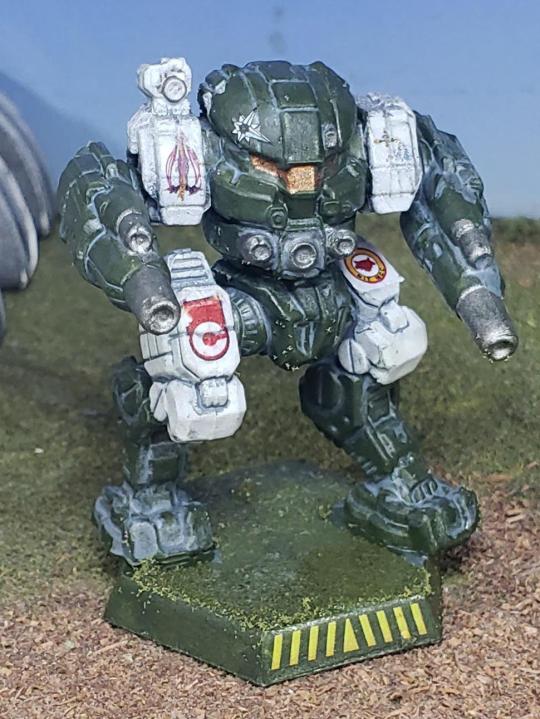

('Mech paintjobs by Luciora on the main BT forums)
6 notes
·
View notes
Text

Banks Lawson of the 455th Air Expeditionary Wing of the U.S. Air Force. Stationed at Bagram Air Base. December 12, 2019.
“This one is good!” Banks called out as he smacked the side of the Black Hawk helicopter he just finished inspecting. “Number 3184 ready for liftoff whenever you’re ready, sir.” Turning, Banks saluted to his superior, Colonel Altman.
“Stand down, Lawson. I’ll take it from here.” The Colonel disappeared into an aircraft hangar to grab the group that would be taking 3184 to the nearby medical hospital.
The day before was hell on earth. The airbase was attacked by a suicide bomber that left 80 wounded and 1 killed. Black Hawk 3184 would be transporting the more critical patients to a safer place to recover.
Banks assisted wheeling gurneys onto the aircraft while doctors and nurses manned their medications and ventilators. It felt surreal. After being stationed there for years, this was the first time Banks witnessed true destruction. He’d been lucky until then; simply repairing and inspecting aircrafts on the day to day. Now, he was watching people with amputated limbs and bloody bandages load into a helicopter he inspected.
Banks and the rest of the airmen staying on the ground watched as the Black Hawk lifted into the clouds and disappeared, silently praying to themselves for safe travels and lives saved.
“Back to work!” Colonel Altman barked, making them all disperse to continue working on the endless amount of repairs that needed done from the previous day’s attacks.
An hour later, everyone’s radios started to pick up the same message. “Mayday, mayday!” Afraid of another bombing, Banks grabbed his radio and took cover beside the plane he’d been working on. “Is anyone there?” They asked. Banks heard a voice over the commotion answer the mayday. “Colonel Altman here. What are your coordinates? What’s happening?”
“It’s Black Hawk 3184.” The shaky voice spoke through the static. “All engines have failed. We’re going down.”
43 notes
·
View notes
Text






The M26 Pershing is a heavy tank/medium tank formerly used by the United States Army. It was used in the last months of World War II during the Invasion of Germany and extensively during the Korean War. The tank was named after General of the Armies John J. Pershing, who led the American Expeditionary Force in Europe in World War I.
It was withdrawn in 1951 in favor of its improved derivative, the M46 Patton, which had a more powerful and reliable engine and advanced suspension. The lineage of the M26 continued with the M47 Patton, and was reflected in the new designs of the later M48 Patton and M60 Patton.
111 notes
·
View notes
Text
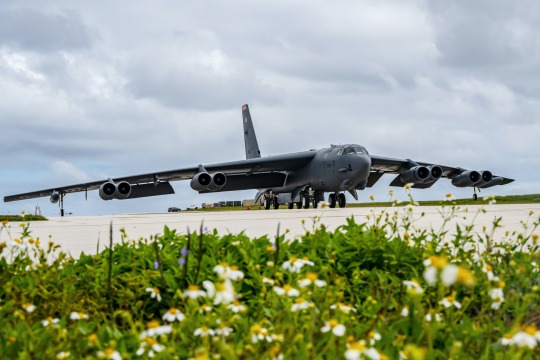
B-52 bombers arrive in the Pacific to provide strategic deterrence
Fernando Valduga By Fernando Valduga 02/05/2024 - 19:39in Military
A B-52H Stratofortress, assigned to the 23º Expeditionary Bomber Squadron, taxis on the flight line at Andersen Air Base, Guam, on January 30, 2024. (Photo: U.S. Air Force / Airman 1st Class Alyssa Bankston)
Four B-52 Stratofortress bombers designated for the 5ª Bomber Wing of Minot Air Base, North Dakota, landed at Andersen Air Base, Guam, in late January, as part of a Bomber Task Force (BTF) to support strategic deterrent missions aimed at strengthening international order rules based on the Indo-Pacific region.
While deployed in Guam, B-52 operations and support personnel are assigned to the 23º Expeditionary Bomber Squadron. The 23º EBS will integrate alongside the Allies and partners to demonstrate the U.S. commitment to security and stability throughout the region.
Designed to show the U.S. ability to deter, deny and dominate, BTF missions aim to influence and deter the aggression of opponents or competitors.

While in Guam, the bombers will also support the largest multilateral exercise of the Pacific Air Forces, the Cope North. The exercise, scheduled from February 5 to 23, will be co-led by the Australian Royal Air Force (RAAF) and the Japan Air Self-Defense Force (JASDF).
Cope North 24 kicks off with ?? ?? integration#CopeNorth24 enhances US relationships & interoperability w/Allies & partners by providing the opportunity to exchange info & improve shared tactics to better integrate multilateral defense capabilities. #CN24pic.twitter.com/99T0YKsspb
— PACAF (@PACAF) February 4, 2024
Reacting to the arrival of the aircraft, Captain Zachary "Smash" Holmes, arms officer of the 23º EBS, said it was great "finally to have some iron on the ground".
"It's great to finally receive our crews, so we're ready to leave and participate in the mission, as well as prepare our maintenance staff to support where necessary," Holmes said. "We are ready to go."

A B-52H Stratofortress, assigned to the 23º Expeditionary Bomber Squadron, taxis on the flight line at Andersen Air Base, Guam, on January 30, 2024. (Photo: U.S. Air Force / Airman 1st Class Alyssa Bankston)
Air crews and support personnel are looking for every opportunity to train alongside our allies and partners to build interoperability and strengthen our collective capacity to support a free and open Indo-Pacific.
Tags: Military AviationBoeing B-52H StratofortressBTFUSAF - United States Air Force / U.S. Air Force
Sharing
tweet
Fernando Valduga
Fernando Valduga
Aviation photographer and pilot since 1992, he has participated in several events and air operations, such as Cruzex, AirVenture, Dayton Airshow and FIDAE. He has works published in specialized aviation magazines in Brazil and abroad. He uses Canon equipment during his photographic work in the world of aviation.
Related news
COMMERCIAL
VIDEO: SAS A320 flight to Manchester was intercepted by RAF Typhoon fighters
05/02/2024 - 15:51
MILITARY
Russian Su-57M fighter with new engine will enter service in 2025
05/02/2024 - 10:08
MILITARY
Discussions between Airbus and Dassault at FCAS are putting the Eurodrone schedule at risk
04/02/2024 - 16:54
ARMAMENTS
Iran presents new missiles and kamikaze drone for its Army Aviation
04/02/2024 - 10:32
MILITARY
United States will send the aircraft carrier George Washington to the coast of Argentina
03/02/2024 - 20:04
AIR SHOWS
For the first time, AirVenture in Oshkosh will have two military demonstration squads in the same year
03/02/2024 - 16:46
15 notes
·
View notes
Text
The Day of Days: Eighty Years After
It was a brisk summer night, almost like any other June night in England.
The terror of the Blitz was long over. Four years ago, the Battle of Britain long had been won. Two years ago in the Pacific the Americans had shocked the world with impossible victories at Midway and Guadalcanal. A year ago, the last German forces had surrendered in North Africa, and the Communists of the Soviet Union had done the impossible and stopped the German war machine in its tracks at the gates of Stalingrad and Moscow before, finally, turning the tide at Kursk. A month early the British Army in India had stopped the Imperial Japanese Army in its tracks at Kohima Ridge, and for the first time in three years the Japanese were on the run. Just a day before, the American Fifth Army had liberated Rome, freeing the "Eternal City" from fascism after twenty years.
They were winning - just. The war was still going on, ever-present in their minds, but they could sleep soundly under a quiet, friendly sky.
But in the dark, in army camps and airfields and naval bases and offices across the southwest of England, the scene was very different. Men whispered to each other, prayers and jokes, trying to lighten the tension in the air, so thick they could cut it with a knife. John Ford - the famed Hollywood director turned Navy Field Photographic unit captain - supposedly told his wife he was going off for a little local skirmish. And in his private office, Dwight D. Eisenhower - Commander, Supreme Headquarters Allied Expeditionary Force - typed the resignation he hoped he'd never have to give. If the unthinkable happened, if this gamble failed...they might never get another chance.
All at once, all across the southwest of England, just before midnight, the quiet was shattered by the roar of thousands upon thousands of piston engines, and thousands of men, some barely out of high school, clambered aboard planes and landing craft for a journey into the dark.
Eisenhower penned a short note, and ensured that a copy was given to every single one of the men under his command. It read, very simply:
"You are about to embark upon the Great Crusade, toward which we have striven these many months. The eyes of the world are upon you. The hopes and prayers of liberty-loving people everywhere march with you. In company with our brave Allies and brothers-in-arms on other Fronts, you will bring about the destruction of the German war machine, the elimination of Nazi tyranny over the oppressed peoples of Europe, and security for ourselves in a free world."
It was June 6th, 1944, and after three years of begging by Josef Stalin, and a year of intense planning, brutal training, unparalleled deception, and massive buildup, the time had come to do the impossible.
The Allies were going to break the Atlantic Wall, or die trying.
It was a herculean task. The Germans had spent four years preparing for just this day, filling every beach from Cherbourg to Amsterdam with every kind of mine imaginable, dotting Czech hedgehogs and wooden posts tipped with high explosives along the shallow coastlines, and building bunkers with encased machine guns and artillery, pre-sighting mortars and artillery, digging trenches and building tens of thousands of pillboxes, and digging enough anti-aircraft positions to turn night into day. In command was Erwin Rommel, the famed "Desert Fox", a veteran of the brutal World War I Italian front, and one of the best tank commanders in the world who had fought across France and North Africa. Under his command were almost half a million German troops, including battle hardened veterans of France, Africa, and Russia.
Standing against them, over a thousand planes and gliders carrying over 23,000 paratroopers from the United States, the United Kingdom, and Canada. Behind them, thousands of fighters and bombers and almost seven thousand landing craft and ships carrying more than 160,000 men from thirteen nations.
The Day of Days began just after midnight.
At 00:48 on June 6th, 1944, the men of the 101st Airborne became the first of to make a terrifying jump into the dark.
It was the beginning of the single largest amphibious invasion ever attempted. Six hours after the paratroopers took the plunge, at 06:30 local time, the first men stumbled onto shore, and into the jaws of death.
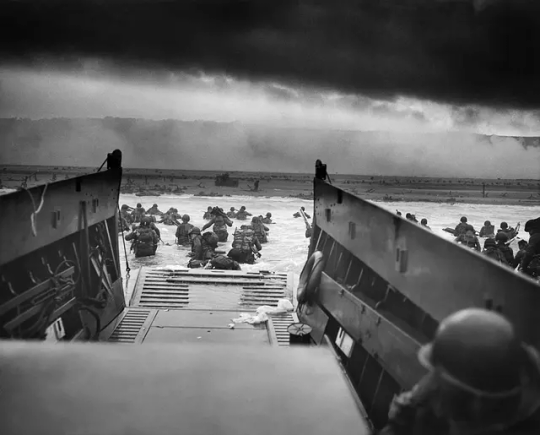

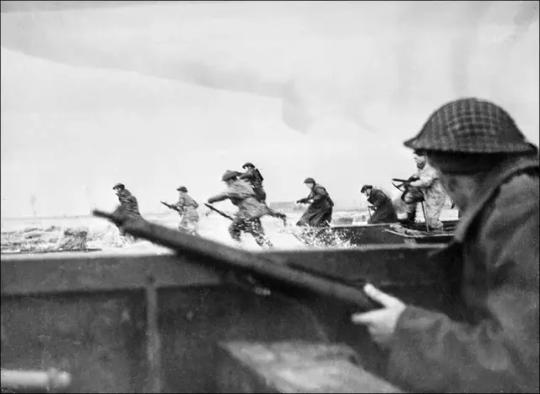
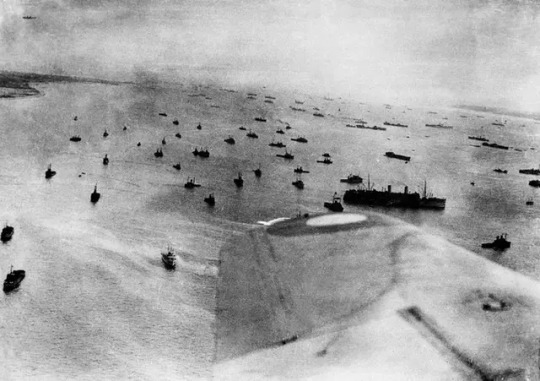

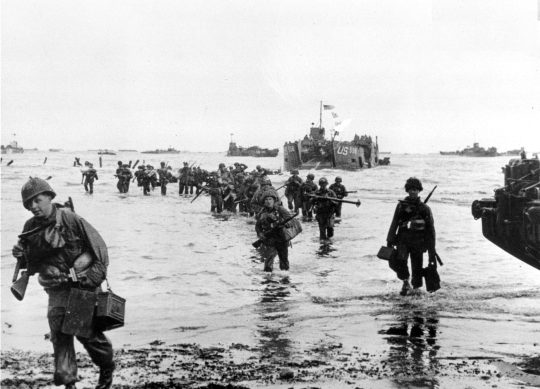
Almost immediately, the entire plan fell apart. Fog, cloud cover, a lack of navigators, and brutal anti-aircraft fire forced many pilots to signal the paratroopers to drop outside their assigned zones, mixing units and men and causing absolute chaos on the ground. The weather in the channel was not much better: high seas swamped many of the landing craft and amphibious tanks, and strong currents pushed entire regiments out of their landing zones.
When the men finally made it to the beach, they faced a desperate run across the dreaded shingle: a nearly half-mile expanse of open sand and rock, with no protection at all from the waiting German defenders. Their fire support - the naval vessels waiting offshore, bristling with guns of all calibers - was of little help; the captains refused to close any farther than the extreme ranges for fear of counter fire. And the bad weather in the skies above prevented pilots from accurate close air support.
Over ten thousand men from both sides would have their lives ripped apart on beaches in just that first day.
On Omaha Beach alone, almost two thousand men were killed. Some didn't even get a chance to face the enemy - instead, they simply drowned, their heavy equipment weighing them down into the cold waters of the North Atlantic. The beaches themselves, its said, turned red with blood as men were killed by the dozen. At Gold, Juno, and Sword Beaches, the Canadians and British managed to make it off the beach, only to be forced into fortified towns, where they endured the brutality and chaos of house-to-house urban warfare. At Pointe du Hoc, between Omaha and Utah Beach, the U.S. 2nd Ranger Battalion were forced to scale a one hundred foot cliff under withering enemy fire, only to become totally cut off. When they were finally relieved after two days, only 65 of the original 200 men were left standing, and they were forced to use captured German weapons as theirs ran out of ammunition, resulting in some of their number being killed due to friendly fire.
The paratroopers faired even worse - of the more than 20,000 American paratroopers and aircrew who made the desperate flight across the Channel, it's estimated that more than twelve thousand were killed.
The carnage was unlike anything anyone in the Allied forces had seen before, unlike Operation Torch or El Alamein in North Africa, unlike the Miracle of Dunkirk or the Battle of Britain, unlike Guadalcanal and New Guinea, unlike Salerno, Anzio, and Sicily.
For this untold sacrifice, this bloody hell that almost two hundred thousand men endured, they had only managed to capture a few square miles, only two of five beaches were connected, and they had failed to capture a single major city or port. The Allies failed to achieve even one of their major objectives - save one.
After five years of war, the Allies had a foothold.
The mother of all Hail Mary's had worked.
By the end of D-Day, almost 160,000 men had crossed the Channel into Fortress Europe.
On D+6, the beaches were finally connected.
On D+7, the city of Carentan was freed by the 101st Airborne, the first major French town to be liberated.
By D+20, the port city of Cherbourg was taken, and the Cotentin Peninsula was free after four long years.
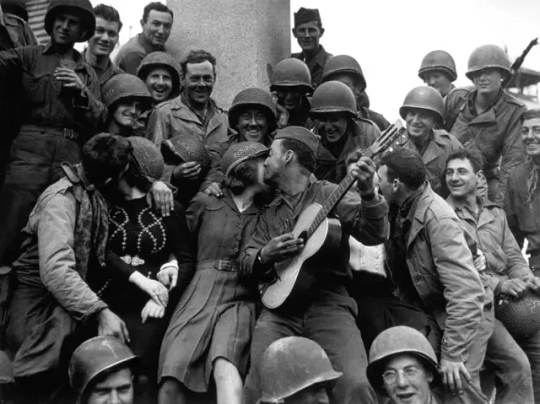
On D+50, the city of Caen was freed, and the objectives of D-Day had finally been completed. By this time, more than 1.5 million men from 15 nations had landed in Europe.
On D+70, the Allies landed on the beaches of Côte d'Azur, and in only four weeks broke the southern German front line, and liberated the entire south of France.
On D+76, the Falaise Pocket collapsed, and the Battle of Normandy was finally declared over in a resounding Allied victory.
Then, at long last, on D+80, General der Infanterie Dietrich von Cholitz, at 3:30 PM local time, surrended the city of Paris to General Phillipe Leclerc. After four years of occupation, the first Allied capital was free. The footage of that day has been called some of the most thrilling and ecstatic footage in history.
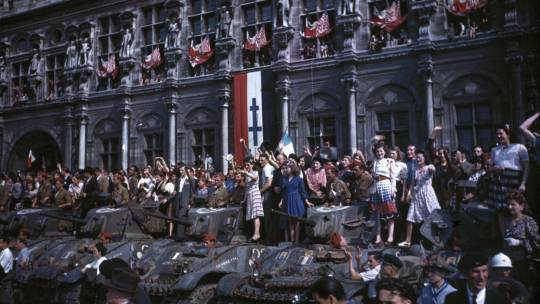
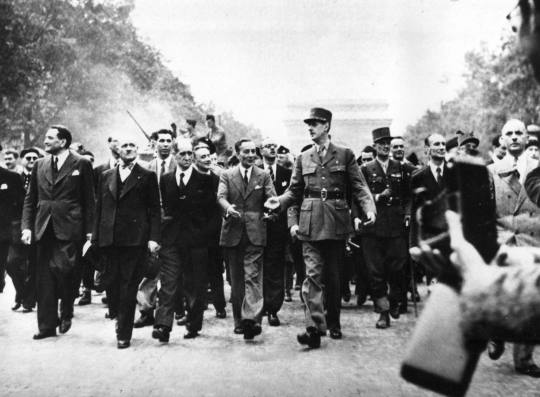
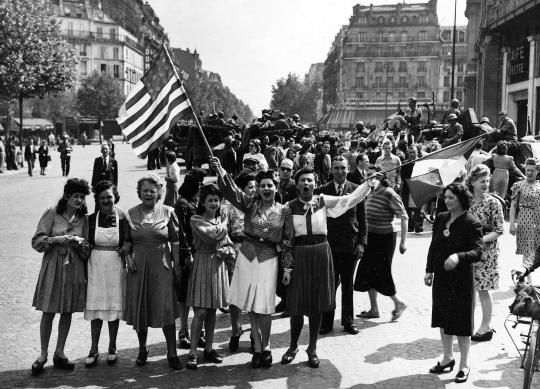

The march continued, and on D+89, the Welsh Guards marched into the Belgian capital of Brussels.
But the war was far from over - on D+193, the Wehrmacht launched Operation Nordwind; the Battle of the Bulge had begun. It would be Germany's last offensive, at the cost of hundreds of thousands of lives.
On D+274, the Allies crossed the Rhine, and liberated the Netherlands, and then finally entered Germany.
On D+303, the U.S. 4th Armored Division stumbled upon a scene of unimaginable cruelty: it was a camp named Ohrdruf, part of the Buchenwald complex, the first concentration camp to be liberated by the United States. Allied intelligence services had long suspected what was going on, that their were camps across Europe for Hitler's "undesirables", and the Allies had even signed a declaration making public and condemning the killing of Jews in Poland, but no one was prepared to see the true scale of the atrocities. Eisenhower demanded that every single piece of the camp be photographed, videotaped, and documented, that everyone possible be brought to see it to impress upon them the reality of what the Germans had done. Hollywood director George Stevens was given the task of making movies describing the horrors of the Holocaust, movies that were later shown to the world at the Nuremberg Trials. The movies were said to be the moment that changed the course of the Nuremberg Trials.
Then, on April 30th, 1945 - three-hundred and twenty eight days after the 'Longest Day' - Adolf Hitler, the man who had been the head of so much destruction, who had started the most destructive war in human history and presided over the worst genocide mankind has ever perpetrated, commits suicide in a bunker in Berlin.
Three days later, on May 2nd, 1945, the surrender of German Army Group C goes into effect, and the Gothic Line that had long since stymied the Allied advance in Italy finally collapses.
And on D+336, eleven months after landing on the beaches of France, Field Marshal Wilhelm Keitel would sign the German Instrument of Surrender, and the German Wehrmacht laid down its arms.
The Reich that Adolf Hitler had once boasted would last for a thousand years had fallen after just twelve.
The War in Europe was over.




Eleven months after he wrote it, the promise Eisenhower made to his men - the destruction of the German Army, the end of Nazi tyranny in Europe - had finally come true.
It had been five and a half long, blood-soaked years since the war in Europe began, but at long last, Europe was free. It would takes years, even decades, to rebuild from the destruction, but finally, there was a tomorrow to live for.
Eighty years on, we still grapple with their sacrifice, and the choices they made afterwards in the world they built. But because of them, we were given a tomorrow to argue in - and a tomorrow to live for. All because thousands from across the world stepped onto a small, windswept beach, and seared the name of Normandy into history.







#history#ww2#d day#normandy#tw death mention#will anyone on tumblr care about this? doubtful#but i wrote it anyways because it's been 80 years and that has decided to occupy all of my writing brain cells
8 notes
·
View notes
Text
REINFORCEMENTS FOR AUN’SHAR
The response team lead by Commander Novastorm was intended to be the tip of the spear in the battle for Maynos. After his Orca dropship broke through the space marine fleet in orbit, however, he intercepted a distress signal coming from Tau forces already on the surface of the planet.

1. The Orcas’ security team has been reassigned to Strike Team Burning Ember, to replenish their ranks after most of the lighter armored members met their demise at the hand of the Necrons. Trained to clear and secure the drop zone, as well as defend within the confines of their dropship, they will be an invaluable addition to the Protectors infantry.

2. The Crimson Order crisis team is comprised of two iridium reinforced battlesuits, and four standard XV8 suits ,two of which are piloted by Shas’Vre rank veterans. The Order operates like a single organism, creating a strong phalanx with their shield generators around the Commander in one instant, then in the next scattering into two smaller teams led by the two Veterans, splitting the enemies’ attention as their Commander takes to the sky for a devastating aerial bombardment. Both of the veterans have equipped their suits with ritual blades, as they have each joined in a separate Ta’liserra, forming the sub-teams Crimson Dusk and Crimson Dawn, which, under the command of Commander Novastorm forms the Crimson Order.

3. Shas’O May’nar Bo’ran, AKA Commander Novastorm, piloting his custom XV-85 Coldstar Commander battlesuit. Despite the warnings of Earth Caste engineers, Bo’ran has removed almost all of the safeties and fine tuned the tolerances on his controls to react to the slightest twitch of his finger. Compared to other Coldstars, his current battlesuit moves three times faster, and can preform VTOL almost instantaneously, at the cost of the thrusters requiring constant maintenance to function. Bo’ran has encouraged the pilots under his command to perform similar modifications to their suits, breaking the limit of what the common XV8 crisis team can be capable of. Beyond the Coldstar thrusters and high-output burst cannon typically seen on a XV-85, Bo’rans’ suit is had been outfitted with an ejection system, shoulder mounted fusion blasters, a multi tracker targeting system, and the prototype Supernova Launcher, a modified grenade launcher that can hurl plasma grenades great distances, setting fire to organics and melting metals.

4. The Hammerhead gunship was intended to be used as a deterrent for enemies that would try to come close to the Orcas’ drop zone. Crewed by 3 skilled pilots, all work in tandem to fire pinpoint railgun slugs, decimating enemy armor from an incredible distance. The communication relay that was kept in its hull has been removed and left within the Orca, giving room for Aun’Shar and his infantry to board.

.5. The Orcas’ drone bays have been emptied for the greater good and support the expeditionary force. The presence of drones were sorely missed by the survivors of Aun’Shars’ honor guard, who were not requisitioned drones with the assumption that they would not ever be under heavy fire. With the last of the Orcas’ cargo unloaded, it will be at greater risk on its journey back to the fleet, but if the life of an ethereal hangs in the balance, such risk becomes almost necessary to ensure his safety.
________________________________________
As the Orca roars back into the atmosphere, Aun’Shar climbs into the Hammerhead. It’s a tight fit with the number of soldiers packed in, but not uncomfortable. Slowly the Hammerhead floats into the dark recess of the vault, closely followed by the escort of battlesuits and drones. Aun’Shar squeezes by his warriors to look out the viewport at the Maynos sun, wondering if this will be the last time he sees it as the blackness swallows his gunship.
#fanfic#warhammer 40000#sci fi oc#battle report#tau empire#warhammer 40k#warhammer miniatures#warhammer oc#warhammercommunity#warhammerpainting#warhammer#painting warhammer#miniature painting#tau 40k#tau#3d printing
29 notes
·
View notes
Text










Maryhill Stonehenge, WA (No. 4)
On June 8, 1918 a total eclipse of the sun was predicted, with the best viewing point in the vicinity of Goldendale, Washington. Consequently, some of the best astronomers of the day were in Klickitat County. Professor Campbell, of Lick Observatory at the University of California, agreed to fix the position of the altar stone. Unlike the ancient Stonehenge, it is aligned to the astronomical horizon rather than the actual midsummer sunrise. This results in a three degree difference from the original structure. Combined with a five degree difference in latitude and the manner in which the surrounding hills obscure the actual horizon, Stonehenge Memorial is difficult to use as an astronomical calendar.
On July 4, 1918 the altar stone was dedicated with a plaque that reads:
To the memory of the soldiers and sailors of Klickitat County who gave their lives in defense of their country. This monument is erected in hope that others inspired by the example of their valor and their heroism may share in that love of liberty and burn with that fire of patriotism which death alone can quench.
Stonehenge Memorial was completed in 1929 and re-dedicated on Memorial Day of that year. The men honored at Stonehenge are James Henry Allyn, Charles Auer, Dewey V. Bromley, John W. Cheshier, William O. Clary, Evan Childs, James D. Duncan, Harry Gotfredson, Robert F. Graham, Louis Leidl, Carl A. Lester, Edward Lindblad, Henry O. Piendl and Robert F. Venable.
These men, all members of the American Expeditionary Force, represented the U.S. Army (Cavalry, Coast Artillery, Engineers and Infantry), U.S. Marines and the U.S. Navy.
When Samuel Hill died in 1931, his body was cremated and the ashes placed in a crypt just below the Stonehenge Memorial. The original crypt deteriorated in the next 25 years and was replaced in 1955 by a granite monument bearing his epitaph: “Samuel Hill: Amid nature’s great unrest, he sought rest.”
Source
#Sam Hill Memorial Bridge#Columbia Gorge#Maryhill Stonehenge Memorial by Sam Hill#Klickitat County#Washington#USA#summer 2023#Pacific Northwest#travel#original photography#vacation#tourist attraction#landscape#landmark#countryside#architecture#WWI#World War One#US history#free admission#Columbia River
3 notes
·
View notes
Text

Lance Cpl. Davonte Black and Cpl. Daniel Aboytegamez, combat engineers with India Company, 3rd Battalion, 3rd Marine Regiment, practice clearing a route for amphibious assault vehicles during a platoon live-fire event at Pohakuloa Training Area in Hawaii.
Lance Cpl. Luke Kuennen / US Marine Expeditionary Force, August 24, 2017
6 notes
·
View notes
Text

Reginald, known as Reggie, was the eldest son of William (Bill) Stenning and his wife Emily
Stenning nee Gander. He was born in late 1891 and baptised here on 01/11/1891. His father was a
gardener and the family lived at Treeps Cottage. He is listed at home on both the 1901 and 1911
censuses when he was a baker’s assistant.
Reggie’s papers have recently been digitised but form part of the ‘burnt documents’ severely
damaged in an incendiary attack on the repository during WW2. Reggie’s papers are missing large
sections. It is possible to work out that he joined the 1/1st Sussex (Fortress) Reserve of the Royal
Engineers as a sapper on 16/11/1914 and was numbered T224, the ‘T’ indicating this was a Territorial
unit. This unit was based in Newhaven and their role was local defence. As the dangers of invasion
receded six engineer units formed the 1/1st Sussex Army Troops Company, RE. With their specialist
knowledge they left England on board the Empress of India arriving at Le Havre on 20/03/1915
joining the British Expeditionary Force at Etaples. At some point Reginald was raised to Lance
Corporal and, although the date cannot be read, it is most likely to have been before he entered
France. The Company was employed building accommodation for the arriving troops and hospitals
and roads around Etaples. They were moved to Vimy Ridge in May of 1916. Here their role was to
extend the deep dugout and tunnel systems under the ridge. One of their innovations was to construct
a ropeway slung from the roof to carry the spoil out to the surface. This system was later adopted by
other units. They also built concrete machine gun positions, and if that were not enough, some of
them, reportedly, helped the local farmers with their harvest.
In late 1916 a reorganisation of troop numbering of the Territorial Forces was undertaken. Six figure
numbers were allocated and the Sussex Fortress men were given numbers starting at 545001 on 01/
02/1917. Reggie was renumbered 545119. Just two days before this Reggie was hit in the leg by a
shell splinter. He was taken to 45 Casualty Clearing Station based at ‘Edgehill’ near Dernancourt but
died the following day. He is buried in the Dernancourt Communal Cemetery Extension in grave IV.
H. 8. He is remembered on both local war memorials.
Grave B102 in the South Avenue Cemetery holds a member of the Stenning family. In 1920 an Act of
Remembrance laid flowers on the graves of all servicemen who had died. Reginald is mentioned in
the newspaper article and it is possible that flowers were laid here. There is no stone.
Reginald, bekend als Reggie, was de oudste zoon van William (Bill) Stenning en zijn vrouw Emily Stenning - Gander. Hij werd eind 1891 geboren en gedoopt op 01/11/1891. Zijn vader was een tuinman en het gezin woonde in Treeps Cottage. Hij staat vermeld op zowel de 1901 als de 1911 gehouden volkstellingen toen hij bakkersknecht was. Reggie's papieren zijn onlangs gedigitaliseerd, maar zijn ernstig beschadigd bij een brandbomaanval op de opslagplaats tijdens WO2. Van Reggie's papieren ontbreken groot gedeelten. Het is mogelijk om eruit op te maken dat hij zich aansloot bij de 1/1st Sussex (Fortress) Reserve van de Royal Genie als sappeur op 16/11/1914 en was genummerd T224, de 'T' gaf aan dat dit een Territorial eenheid was. Deze eenheid was gestationeerd in Newhaven en hun rol was vooral lokale verdediging. Toen de gevaren van een invasie afnamen werden zes genie-eenheden gevormd in de 1/1st Sussex Army Troops Company, RE. Ze verlieten Engeland aan boord van de Empress of India, waar ze op 20/03/1915 in Le Havre aankwamen en zich aansluiten bij de British Expeditionary Force in Etaples. Op een gegeven moment werd Reginald gepromoveerd tot Lance Korporaal en, hoewel de datum niet kan worden achterhaald, is het zeer waarschijnlijk dat het was voordat hij Frankrijk binnenkwam. De compagnie werd ingezet voor het bouwen van accommodatie voor de aankomende troepen en ziekenhuizen en wegen rond Etaples. Ze werden in mei 1916 verplaatst naar Vimy Ridge. Hier was het hun taak om diepe dug-outs en tunnelsystemen onder de heuveltoppen te graven. Een van hun innovaties was het bouwen van een kabelbaan die vanaf het dak wordt gebruikt om de specie naar de oppervlakte te brengen. Dit systeem werd later overgenomen door andere eenheden. Ze bouwden ook betonnen mitrailleurstellingen, en alsof dat nog niet genoeg was, naar verluidt hielpen ze de lokale boeren met hun oogst. Eind 1916 werd een reorganisatie van de troepennummering van de Territoriale Strijdkrachten ondernomen. Zes nummers werden toegewezen en de mannen van Sussex Fortress kregen nummers vanaf 545001 op 01/ 02/1917. Reggie werd omgenummerd tot 545119. Slechts twee dagen eerder werd Reggie in zijn been geraakt door een granaatsplinter. Hij werd naar 45 Casualty Clearing Station gebracht, gestationeerd in 'Edgehill' bij Dernancourt, maar overleed de volgende dag. Hij ligt begraven op de Dernancourt Communal Cemetery Extension in graf IV. H. 8. Hij wordt herdacht op beide lokale oorlogsmonumenten. In 1920 werd in het kader van de herdenking bloemen op de graven van alle gesneuvelde militairen gelegd. Reginald wordt genoemd in het krantenartikel, gewijd aan deze herdenking.
9 notes
·
View notes
Text

Admiral Michelle Janine Howard (born April 30, 1960) is the first African American woman to command a Navy ship and the first woman of any race to attain the rank of admiral. Born in Riverside, California, she was one of four children of Air Force Master Sergeant Nick Howard and Philippa Howard. She entered the Naval Academy at Annapolis, where she graduated with a BS in Mathematics and was commissioned as an ensign in the Navy.
Her first sea duty was aboard the submarine tender USS Hunley for three years. She served on the aircraft carrier USS Lexington as a main engines officer. She earned the Secretary of the Navy/Navy League Captain Winifred Collins Award. She began service on the ammunition ship, the USS Mount Hood, as the chief engineer which resulted in her participation in Operations Desert Shield and Desert Storm. She reported for duty as first lieutenant on the USS Flint. She became an executive officer on the docking ship USS Tortuga. She sailed to West Africa for a multi-nation training cruise.
She made history when she captained the dock landing ship USS Rushmore with a crew of more than 400 sailors, thus becoming the first African American woman to command a Navy ship. She led Amphibious Squadron Seven, deployed with Expeditionary Strike Group 5. She was promoted to Rear Admiral. She led Expeditionary Strike Group 2, deploying to CENTCOM theater where she commanded Task Force 151. She led Task Force 51, Expeditionary Forces. The event inspired the movie, Captain Phillips. She was the Maritime Task Force leader for BALTOPS.
President Obama lifted the ban on women serving in combat and pushed the effort to place more female soldiers in high-level defense positions. She was promoted to Vice Admiral and held the post of Deputy Commander of US Fleet Forces. She became a full Admiral, the first Navy woman ever to reach a four-star rank. She became the 38th Vice Chief of Naval Operations. She retired in December 2017.
Her recognitions are the NAACP Image Award, Women of Color STEM Career Achievement Award, and the USO Military Woman of the Year. She is married to retired Marine Captain Wayne Cowles. #africanhistory365 #africanexcellence #deltasigmatheta
4 notes
·
View notes
Text

F-15C Eagles from the 44th Expeditionary Fighter Squadron - PICRYL - Public Domain Media Search Engine Public Domain Search
Download Image of F-15C Eagles from the 44th Expeditionary Fighter Squadron. Free for commercial use, no attribution required. F-15C Eagles from the 44th Expeditionary Fighter Squadron takeoff at Prince Sultan Air Base, Kingdom of Saudi Arabia, Aug. 25, 2020. The 44th EFS conduct flying sorties daily to deliver air dominance in the U.S. Central Command's area of responsibility. (U.S. Air Force photo by Staff Sgt. Cary Smith). Dated: 24.08.2020. Topics: deployed, centcom, uscentcom, saudi arabia, deterrence, afcent, f 15 eagle, usafcent, air force, united states air force, usaf, air dominance, deployed airmen, kingdom of saudi arabia, ksa, cary smith, staff sgt cary smith, prince sultan air base, psab, 378 aew, 378th air expeditionary wing, 378th aew, wintoday, prevailtomorrow, 44 efs provides deterrence support to region, dvids, ultra high resolution, high resolution, jet aircraft, military aircraft, us air force
6 notes
·
View notes
Text
Ryūga - THE LAST DRAGON'S ASCENT
DCS Tenryū
Approaching SLS Ulithi
Zenith Jump Point, Luthien System
Pesht Military District, Draconis Combine
Late September, 3153
The SLS Ulithi hung in the void like a silver monolith, a monument of the reborn Star League’s might, its silvery hull a stark contrast against the cold light of the stars. Though the Potemkin-class WarShip was a construct of pure function, there was an undeniable grandeur to it—a fortress of war, a bastion of discipline and control.
Aboard the DCS Tenryū, Gunji-no-Kanrei Ryūga Kurita stood at the primary docking corridor, waiting for the final connection to complete. His emerald eyes traced the docking collar’s structure, noting the flawless precision of the SLDF engineering, a quiet hum of mechanical synchrony marking the vessel’s every movement. Beside him, Tai-sa Reika Jurobei and Chu-sa Dahiya Ult Salah-Miyamoto stood in perfectly poised silence, mirroring his stillness. Behind the trio were the commanders of the 10 other regiments assigned to the Dragon's expeditionary force, shuttled over to the Tenryū, to be received as one group.
The hatch cycled open, revealing a contingent of SLDF personnel, their uniforms immaculate in black and gray, their posture flawless in its discipline. At their head stood Captain Eliza Tagore, the commanding officer of the Ulithi, her iron-gray hair immaculately tied back, her bearing proud yet perfectly respectful.
And then, as one, the assembled officers and crew bowed.
It was a deep, precise motion, a gesture that spoke of absolute decorum, absolute understanding of protocol. For Ryūga, they bent almost to the deck, an honor reserved for one who stood as the left hand of the Coordinator herself. And though he was not one to demand such displays, he understood the weight of the moment—and so, magnanimously, he returned the gesture, not as deeply, but enough that none could mistake the respect he held for the Star League Defense Force.
For Reika, the bow was less extreme, but still deeply formal, befitting her high station as a senior officer of the Combine’s elite. Dahiya’s was slightly less pronounced, but still one of great honor, acknowledging her as a commander of warriors, a leader of shadows.
The moment stretched, silent save for the gentle hum of the WarShip’s systems, until at last, Tagore straightened, her expression composed.
“Gunji-no-Kanrei Kurita-denka, Tai-sa Jurobei-sama, Chu-sa Salah-Miyamoto-sama, welcome aboard the SLS Ulithi.” Her voice was measured, warm yet disciplined, her Japanese flawless, spoken with the precise intonation of one who had studied not merely the language, but the culture itself.
“Tagore-san, your welcome is most gracious,” Ryūga replied, his voice smooth, deliberate, his tone bearing the weight of centuries of Kuritan refinement. He gestured lightly to the assembled personnel. “The precision of your crew does great honor to the Star League.”
There was no flicker of arrogance in his words, only genuine respect, and it was received as such.
Tagore inclined her head, acknowledging the statement before stepping aside. “If you will accompany me, we have prepared the bridge for your arrival.”
Ryūga gave a single, elegant nod. “Lead on.”
---
The bridge was a masterpiece of control and efficiency, vast and immaculately ordered, its steel-gray surfaces reflecting the cold luminescence of holotables and control stations. As with the bridges of all WarShips, there was no flourish to its design, only pure, uncompromising function—but even Ryūga, who favored the aesthetics of the Dragon’s domain, could not deny the immense presence of the command center.
As they entered, the SLDF bridge officers straightened, executing a crisp, synchronized bow, their movements perfectly measured, precisely aware of the honor due to each guest. It was a performance of discipline, of respect, of a military that understood both its power and its place within the great order of things.
Tagore led them to the primary holotank, its display shimmering to life, showing the navigation parameters for their journey.
“As you are aware,” she began, “our destination is Islington, a journey of nearly 850 light-years. Standard calculations would require over a dozen jumps and multiple recharge stops, not to mention months of time—but the Ulithi is a special WarShip.”
She tapped a control, and the schematics of the K-F drive flickered into view, alongside historical notes referencing an myriad of topics.
“We are equipped with Super-Jump technology, originally theorized and realized by Interconnectedness Unlimited, later refined with Blakist advancements, and perfected using systems recovered from the SLS Manassas. This allows us to execute jumps of up to 240 light-years per charge—and with our Lithium-Fusion Battery system, we can chain two jumps in succession before recharging. As such, our trip to Islington will be completed in four jumps, with a single 48-hour recharge stop mid-way.”
Reika absorbed the information without reaction, but inwardly, her mind turned over the implications. Such efficiency… If the SLDF could move fleets with this kind of speed…
Dahiya’s ears twitched slightly, but she remained silent. A three-day journey across a distance that should take months? The possibilities, the strategic advantages, were staggering.
Ryūga gave a slow nod, his emerald gaze unreadable. He understood what this meant—not just for the SLDF, but for the balance of power itself.
Tagore folded her hands behind her back. “I understand that your quarters will remain aboard the Tenryū—a most practical decision, given the limitations of our accommodations compared to those befitting the Kanrei.”
Ryūga inclined his head. “A necessary choice, but one that does not diminish my appreciation of your hospitality.”
A flicker of something—approval, perhaps—crossed Tagore’s expression before she continued.
“In that spirit,” she said, “I would be honored if you, along with the commanders of your regiments, would join me for a formal dinner prior to our first jump.”
There was no hesitation in the reply.
“We accept, Tagore-san,” Ryūga said, his voice carrying the weight of both station and sincerity.
Tagore nodded. “Then it will be my pleasure to host you, Kurita-denka."
As the Captain and her guests exited the bridge, turning control over to Tagore's executive officer, the crew of the Ulithi continued their preparations.
4 notes
·
View notes